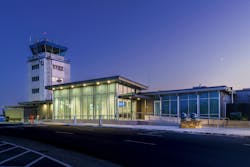Charles M. Schulz Sonoma County Airport Terminal Redevelopment Project Reflects the Region’s Unique Identity
The Charles M. Schulz Sonoma County Airport Terminal has undergone a remarkable transformation, evolving from a modest facility into a modern gateway that reflects the region's unique identity. Through meticulous planning, innovative design, and collaboration among key stakeholders, the redevelopment project has not only addressed critical infrastructure needs but also celebrated the legacy of Charles Schulz and embraced the essence of Sonoma County's wine country.
"We realized that a minimal project wouldn't suffice to meet the growing demands of our airport,” said Charles M. Schulz Sonoma County Airport Manager Jon Stout. “The influx of passengers and the recognition of Sonoma County as a prime destination necessitated a comprehensive redevelopment to accommodate the increasing traffic and provide a memorable experience for travelers."
The original terminal, constructed in the 1960s, struggled to cope with the surge in passenger traffic and the evolving needs of modern aviation.
Between 2007-2020, the Charles M. Schulz Terminal grew from one airline with two daily flights to five airlines and 21 daily departures serving 11 destinations: all departing from a triple-wide modular trailer.
Tim Dacey, Architecture Business Unit Leader at Mead & Hunt, highlighted the urgent need for expansion and renovation, "The original terminal was nearing the end of its unrenovated life. We embarked on a journey to reimagine the space, adding approximately 30,000 square feet and renovating existing structures to create a modern and functional terminal."
The modernization program completed in 2023 provided eight new gates, airside concessions, a security checkpoint, baggage claim, rental car area, ticketing hall upgrades, baggage screening and make-up, airline and TSA offices, apron, and landside improvements. A total of 30,000 SF of new construction was added to the renovated 11,000 SF terminal.
Inspired Design Elements
The Sonoma Wine Country vernacular was adapted into the building forms and detailing – providing light filled monumental spaces. Carbon reducing wood trusses and a cross-laminated timber (CLT) roof deck were implemented. Wine barrel staves from local wineries were incorporated into the gate counters, and other art installations capture local creative talents.
Mead & Hunt Project Architect Erik Schroeder emphasized the importance of incorporating elements that capture the essence of Sonoma County's wine country, "The design drew inspiration from agrarian and industrial structures found in the region, using materials like wood and steel trusses to create a sense of place and celebrate the local heritage." The terminal's main forms were designed to reflect the character and nature of wine country, with large, barn-like structures evoking the region's wineries. The project includes a landside observation area of the airfield from within the terminal.
The legacy of Charles M. Schulz, creator of the beloved Peanuts comic strip, is deeply intertwined with the fabric of Sonoma County. His contributions to the community, both as an artist and a philanthropist, have left a mark on the region. At the Charles M. Schulz - Sonoma County Airport, honoring his namesake was not only a tribute to his remarkable achievements but also a celebration of the local heritage.
"Charles Schulz had his primary studios in Santa Rosa and was deeply involved in community activities. His connection to the airport, as a pilot and through his son Craig, made it fitting to name the airport after him,” Stout said.
The redevelopment project provided an opportunity to integrate Peanuts-themed elements into the airport terminal, further embracing Schulz's legacy.
"We worked with Creative Sonoma and the Peanuts museum to incorporate artwork into the terminal. This included tile mosaics at restroom entrances featuring Peanuts characters, vinyl characters in the no-pass-back exit system, and a bronze statue of Charlie Brown and Linus,” Stout said.
The inclusion of Peanuts-themed features was not merely decorative but aimed at enhancing the passenger experience.
"We wanted to create a sense of motion, so we worked with Peanuts to install vinyl characters depicting the characters in motion. Additionally, we suspended models of Snoopy and the Red Baron in the rental car area, creating an immersive experience for passengers."
The inclusion of Peanuts-themed elements not only pays homage to Schulz's artistic legacy but also celebrates his connection to aviation.
"The presence of Snoopy in a dogfight with the Red Baron, as depicted in our terminal, pays tribute to Schulz's aviation passion and adds a unique touch to the airport experience,” Stout said.
Challenges and Successes
The project encountered various challenges, including limited space for construction and budgetary constraints. However, effective collaboration, creative phasing strategies, and adjustments during construction enabled the project to overcome these obstacles successfully.
"We had to navigate tight budgets, physical constraints, and the onset of the COVID-19 pandemic. Despite these challenges, we remained committed to delivering a terminal that would meet the needs of the airport and its passengers,” Dacey said.
The redesign prioritized maximizing available space while ensuring passenger comfort and convenience. This involved careful planning of phasing, integrating outdoor seating areas, and providing amenities such as ample lounge space, restrooms, and concessions to enhance the passenger experience.
"John Stout, the airport director, was passionate about supporting the passenger experience. We worked closely with the airport to ensure that the terminal would provide a welcoming and comfortable environment for travelers,” Schroeder said.
Stout said one of the more unique furniture additions came from Arconas.
“Arconas makes a product that looks like a tree. It’s internally lit. They can look like a Birch tree … you can change the leaves and format, but you can also have a stand-up table around it. We decided to get those and one of them is the ‘kite eating tree’. So, there's a big red kite with string hanging out it to further reference the Peanuts,” he said.
Sustainability and Future Growth Initiatives:
Incorporating sustainability features was a key aspect of the redevelopment project. Measures such as maximizing natural daylighting, using environmentally friendly materials like cross-laminated timber, and implementing energy-efficient systems were adopted to reduce the carbon impact and enhance energy efficiency of the terminal.
"We were conscious of the environmental impact of the project and sought to minimize our carbon footprint wherever possible. From energy-efficient lighting to sustainable building materials, sustainability was at the forefront of our design considerations,” Dacey said.
Looking to the future, Dacey said the recently completed project marks just the beginning of a series of potential expansions for the terminal.
"The project was designed to support future growth and expansion,” he said. “We recognized the need for a terminal that could evolve with the airport's needs, and we laid the groundwork for future expansions."
He continued, "The long-term vision is indeed going to take a while. So, the second thing was, what's the best use of the land and the available space we can do right now to do the most good."
A Construction Manager at Risk (CMAR) was brought early onto the project team to coordinate the complex phasing and limited construction area. This was the first CMAR project in Sonoma County. The CMAR allowed for the coordination of operational complexities of keeping the airport operational, working through COVID-19, increasing the scope with added funding, and managing nine separate phases.
Key Participants in the project included: Mead & Hunt, Q&D Construction, and C&S.




